1ABCS00226-Chevrolet GMC Cadillac Front & Rear 4 Piece Brake Caliper Set TRQ CLA35003
Replaces
2003 GMC Yukon XL 1500 All Wheel Drive Front & Rear 4 Piece Brake Caliper Set TRQ CLA35003
Product Reviews
Loading reviews
5.00/ 5.0
4
4 reviews
Exactly what I needed at a great price
October 14, 2021
I have had these calipers installed for about a month now. They fit and preform just like O.E.M.
September 6, 2023
Great product just wish they had brake pads to fit the rear calipers.
Best buy and quality whether online or at a parts store
October 3, 2023
With free shipping, you can't beat the price or the quality of these calipers from 1A Auto.
Customer satisfaction
February 26, 2024
Quality parts and great prices. User friendly website and return process.
Customer Q&A
Will these fit A03 suburban 1500. 2 wheel drive?
October 16, 2021
Where are these parts made?
September 12, 2024
10
TRQ is a high quality, high-end name brand that we offer and back with our 1A Auto Limited Lifetime Warranty. TRQ parts are made in multiple overseas countries.
September 12, 2024
Andra M
10
See the above response
September 12, 2024
GARY L
GMC is a registered trademark of General Motors Company. 1A Auto is not affiliated with or sponsored by GMC or General Motors Company.
See all trademarks.

















